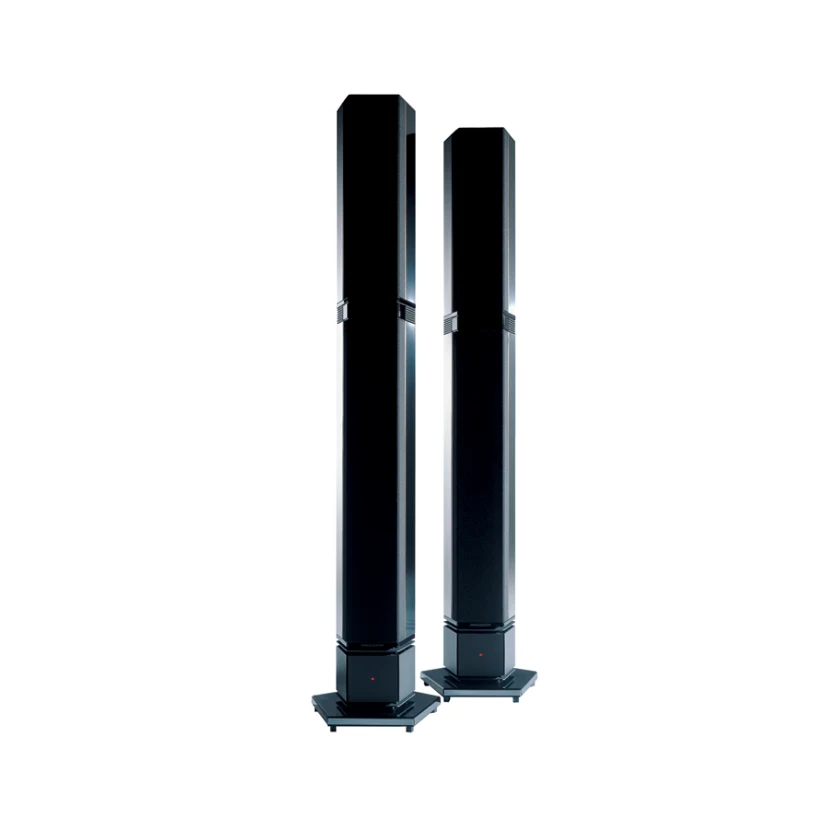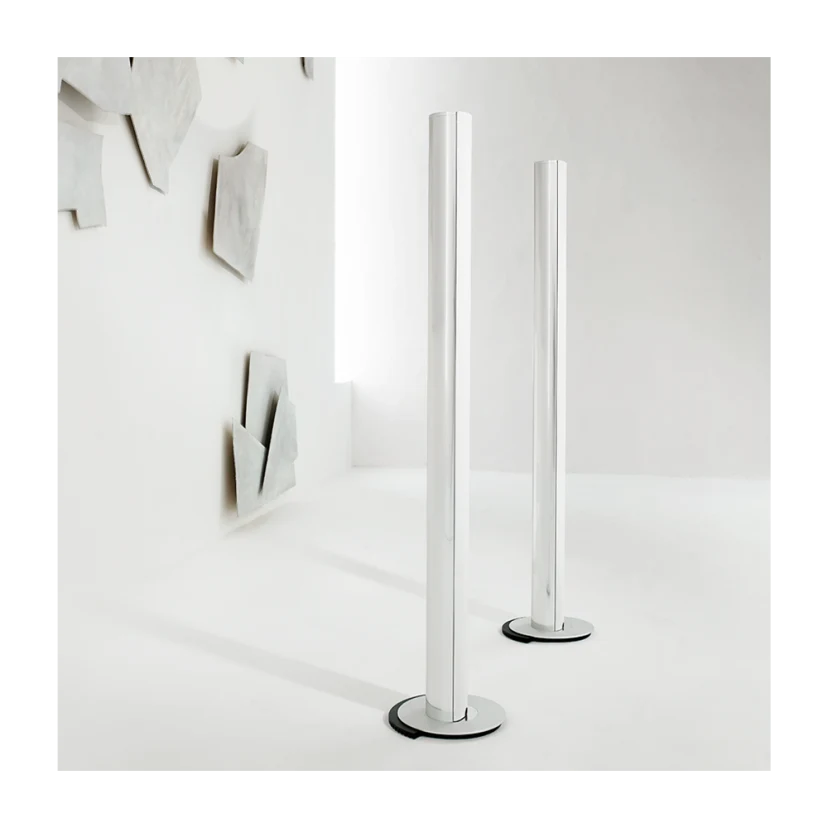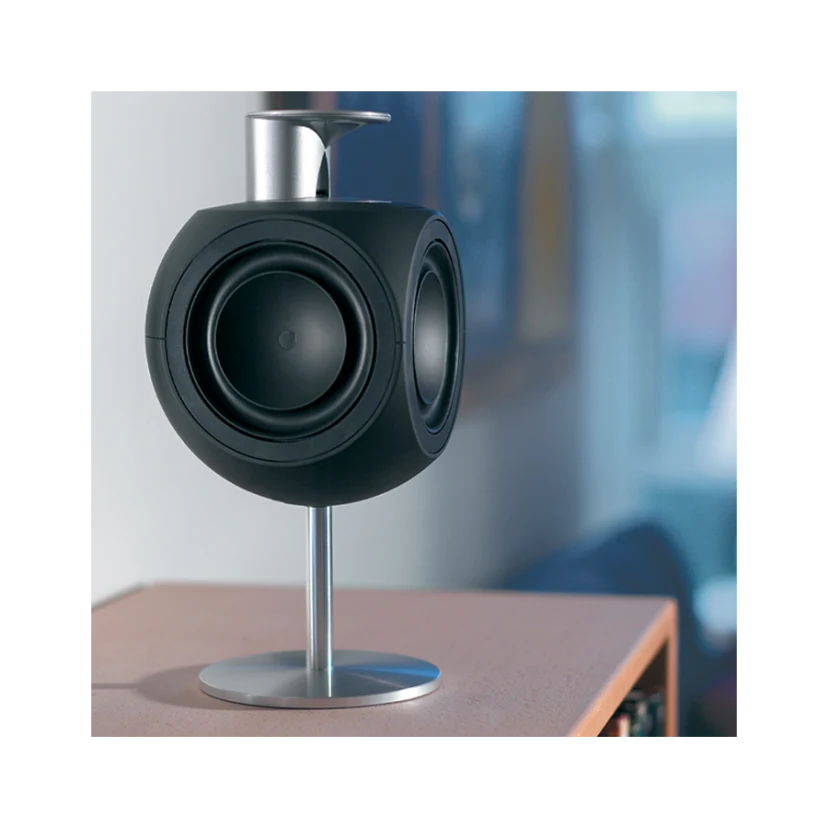Beolab History

Initially, the term Beolab was used for amplifiers. In the 60ies and 70ies, an amplifier was a separate unit – a highly sophisticated part of the setup with radio and connected speakers. Intense competition from Japanese manufacturers demanded a strong signal that Bang & Olufsen was not merely the design and looks – but very much about technology and innovation. In the early days of Hi-Fi, Bang & Olufsen engineers set out to develop the world’s most perfect Hi-Fi system – the Beolab 5000 series in 1967. The brief said: create the European Hi-Fi format which communicates power, precision and identity. The name Beolab – coming from the Bang & Olufsen (Beo) laboratories (lab) – was chosen to make this statement. Also, the designer Jacob Jensen was heavily inspired by what was going on in the laboratory. He used a common laboratory tool in those days – the slide rule as inspiration for his design of Beolab 5000.
Column Speakers
Today it can be hard to understand how radical the Beolab Penta loudspeaker was in 1986. At the time, a normal speaker in your home was a big square box, mostly in wood. That also was true for speakers from Bang & Olufsen.
But engineers at Bang & Olufsen, who participated in a big research project ‘Archimedes’, found that the box design gave unwanted reflections from ceiling and floor affecting the sound performance in a negative way. They started working on a principle that could direct especially the high and midrange frequencies more towards the listener avoiding this.
This led to the pentagonal column design of the Beolab Penta – an unseen design for living room speakers – that not only through its placement of the driver units (which focused the sound to the listener), but also the pentagonal cabinet reduced standing waves and vibrations inside the cabinet.

With the first semi-active loudspeaker – the Beolab Penta – the amplifier unit was moved away from the tuner and placed inside the column speaker for the first time. Beolab Penta was followed by more fully active loudspeaker designs, where each driver unit had its own amplifier. The amplifier was no longer needed as a separate unit. The term Beolab was used for all active speakers making it easy to distinguish from passive speakers (Beovox).
Moving the amplifier closer to the speaker units
In an attempt to make a true high-performance speaker, engineers also wanted to reduce the distance from the amplifier to the driver units.
In those days an amplifier was a separate unit which had cables running from the speakers to its placement typically next to the radio. By placing the amplifier close to the driver units, the loss from the long cables was reduced. In Beolab Penta, the amplifier was placed at the foot of each column.
Become part of the furniture with a small footprint and a reflecting surface
Besides directing the sound towards the listener, the column design had another benefit. The footprint in the living room was relatively small. Also, by designing the speaker in a reflecting stainless-steel surface, it would take up colour from the surroundings and blend into the interior design. Designers Lone and Gideon Lindinger-Löwy were the masterminds behind this innovative design, which took the speaker away from the wall and into the room for the first time. Slim like a Giacometti sculpture and based on an acoustic line-source principle, the Penta had a particularly powerful bass without the boominess that plagued most other large loudspeakers due to the floor’s reflections.
Expensive but value for money
At the time, many Bang & Olufsen retailers thought Beolab Penta would never make it, the price tag was significant and the design was exceptionally bold. Time has of course proved them all wrong, and even today a lot of enthusiasts around the world refer to Beolab Penta as a major breakthrough product.
Column design became the new hit
The column design has become a signature design of many popular Bang & Olufsen speakers since then; Beolab 8000, Beolab 6000, Beolab 8002 and 6002, Beolab 1 and Beolab 18 – and today it is probably the most copied loudspeaker-design of all times.

Beolab 8000 was the first fully active column loudspeaker introduced in 1992. It was the next in a series of compact, slim sound columns for placement on the floor. Beolab 8000 was designed by David Lewis, who was inspired by an organ pipe he found at a flea market. A symbol of both music, but also with a lightness and timelessness in its design that held the potential of having a long life in your home.
The precondition for being able to pursue this design, was the development of new technologies for the fully active column speakers. Beolab 8000 was reincarnated in 2016 in Beolab 18 a seducing sound icon offering an Acoustic Lens, elegant wooden lamellas at the front, based on a new digital sound engine. It had a built-in wireless module so Beolab 18 could connect to any WiSA compliant transmitter, avoiding the need for speaker cables. Combining Beolab 18 with Beosound Core points towards the future of offering access to all streaming sources – be it Wi-Fi or Bluetooth based – in an iconic design that seems to last forever.
Insignificant look but significant impact
This was the essence of Beolab 6000. It came out as a result of an invention at the Dolby Laboratories in the US. After a study trip to the USA visiting the Dolby Laboratories, Boston Medialab, the Epcot centre, Hollywood and Lucasfilm, it was clear to the design team at Bang & Olufsen that multi-channel sound and home cinema solutions for the home would be the next big thing. Having as much as five speakers in your living room, however, was a significant pain point that needed to be solved.

Designer David Lewis developed Beolab 6000 from an idea of a speaker that signalled thin, invisible lines in the air – lines that could be repeated many times. So insignificant that you would hardly notice them. It was a difficult task because any kind of uniqueness became annoying to look at after a while.
Using aluminium for speaker cabinets
The result became a thin high gloss polished aluminium tube with black fabric in front of the speaker being able to reflect the surroundings and, in this way, almost disappear in the interior. The use of aluminium for speaker cabinets has since then been applied in many other solutions. The benefit of being able to blend into the interior, being a robust, thin and rigid material, you can shape any way you like, has made aluminium quite a favourite material of both designers and acoustic engineers since then.
Compact Speakers
A constant conflict between performance and design was solved in many different ways. With Beolab 4000 Bang & Olufsen was attempting to make a bookshelf speaker that could be placed almost anywhere. However, the built-in amplifiers radiated too much heat for it to be approved. Designer David Lewis solved the problem, by integrating the heat sink in the design using a geometric shape that allow heat dissipation from the large curved surfaces.
Versatile placement options
Beolab 4000 had many other unique benefits as the curved design enabled a multitude of placement options – in shelving systems, on floor stands, in the ceiling or in corners. Besides the many placement options over the years, Beolab 4000 was also launched in a large number of different bold colours. This versatility has given the Beolab 4000 design an extremely long lifespan. It was carried on in the Beolab 17 loudspeaker, taking the conceptual idea of a versatile bookshelf speaker concept with many placement options into the modern era.
Beolab 3 – compactness taken to the extremes
Beolab 3 is the result of excellent timing, as it is a perfect synthesis of available technologies and a designer’s ambition to make small seem great. Bass takes up a lot of space so it has always been a difficult task to get sufficient bass performance in small speakers, you could place anywhere.

Beolab 3 was centred on two main elements: the very compact loudspeaker combining the shape of a sphere and cube, and the acoustic lens on top.
The loudspeaker construction is unique, as it is a combination of active and passive speaker units and it has been a crucial factor in achieving the compact design. The visual identity was inspired by a very successful and compact subwoofer, Beolab 2, launched a couple of years earlier, which truly showcased the driver units in a bold and novel way.
Beolab 3 included Acoustic Lens Technology, custom-designed ICEpower amplifiers and driver units and was able to adjusts its bass performance to the surroundings with a manual position switch – all learnings that came from studies for the cutting-edge acoustic technologies developed for Beolab 5 to provide superior performance.
Inside out design
The designer made a virtue out of the many technological innovations. Instead of hiding them in a cabinet, he left the drivers visible and designed a powerful and potent look that was a perfect match for the impressive performance.
With its compact design and a variety of stand options, placement on floor, in ceiling, on wall or on a counter top, Beolab 3 became the perfect solution in a surround sound setup – either on all positions or often as very discrete but great performing rear speaker. A cool and compact loudspeaker delivering an impressive sound performance with its power, precision and depth.
Digital Speakers
The ambitions for Bang & Olufsen’s first all-digital loudspeaker were high. An intelligent speaker with a pure and transparent sound – not affected by the placement of the speaker, the decoration of the room or your own listening position. Introducing sophisticated computer technology and advanced algorithms allowed you much more control of what was going on.
Performance over beauty turned into a Dalek
It was a speaker, where technology came first and where the designer, David Lewis, was invited to a listening test. His experience was described like this:
”Made of building bricks and lumps of wood and clay, it looked rather odd and disjointed. The shape was impossible to describe, too. However, during the listening test, I was struck by the fact that the sound reproduction was unobtrusive. My ambition was to come up with a design that emphasised the technology, and the challenge was to add a muscular bass-volume visually to such a gentle sound. By placing the bass unit at the base of the speaker and directing it downwards, the cone-shape emerged. The acoustic lenses in the upper half of the loudspeaker float on a string and add visual lightness despite the speaker’s 61 kg”.
Without David Lewis’ creative input and the freedom compact technology gave the engineers, the loudspeaker would have been the size of a typical cupboard.
According to the press that review Beolab 5 after that, his design gave connotations to the Daleks from the British science fiction series Dr Who.
A collection of technological innovations based on research studies
Beolab 5 showcased a lot of new technological inventions that the acoustic engineers had been working on for many years. In the early 1980s, Bang & Olufsen participated in the Archimedes research project, where it was found that the room layout and the placement of a loudspeaker greatly affects the listening experience. It was proven that floor and ceiling reflections were a major contributor to unwanted disturbances. In order to present the listener with a pure and natural sound, it was important to find a solution to these issues.
New approach to the sweet spot – for people with friends
Beolab 5 was the first product to introduce Acoustic Lens Technology (ALT) a unique design for the high and midrange drivers providing a 180-degree wide sound dispersion of the upper frequencies, and where disturbing reflections from the floor and ceiling were significantly reduced. The technology made it possible to achieve a great experience from several places in front of it. As the Tonmeister then put it: “This is a speaker for people with friends. Most high-end speakers play for one sweet spot and is for people with no friends”.
Identifying the room – the invention of ABC
In the high frequency areas, we found Acoustic Lens Technology to be of great use, but in the bass frequencies the problem was quite different. Bass sound waves are omni-directional, so you cannot really define where they are coming from. The room acoustics and the placement of the loudspeaker in it are important for the bass sound experience. To optimize bass performance, we needed to be able to control these elements, in any room, in any position. To do this Bang & Olufsen invented Adaptive Bass Control (ABC). It was a technology enabling the loudspeaker to examine the acoustic characteristics of the room in which it is placed, and determine its own position within this environment.
The speaker knows where it is in the room
Based on this information, Beolab 5 digitally calibrates itself to ensure the optimum bass reproduction for this specific placement. A moving microphone emerged underneath the 15-inch downwards firing bass unit, sent out a tone and measure what came back. In this way, you could place the speaker where you wanted in the room and let the ABC adjust its performance to this placement. The calibration process was activated by pushing an ‘invisible’ button at the top of the speaker. With its four ICEpower amplifiers producing 2500 watts per speaker the size of the room was no longer an issue – to prove this point, the launch was actually done in a concert hall.